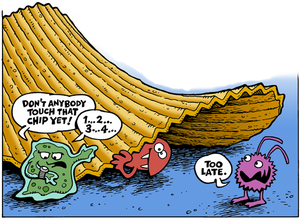Five-second rule
This article needs additional citations for verification. (January 2011) |

A common superstition, the five-second rule states that food dropped on the ground will not be contaminated with bacteria if it is picked up within five seconds of being dropped. Some may earnestly believe this assertion, whereas other people employ the rule as a polite social fiction that will allow them to still eat a lightly-contaminated piece of food, despite the potential reservations of their peers.
There are many variations on the rule. Sometimes the time limit is modified. In some variations, the person picking up the food arbitrarily extends the time limit based on the actual amount of time required to retrieve the food. In Russia there exists a similar rule: "Promptly picked up is not considered fallen".[1]
Research
The five-second rule. The five second rule is false it is actually the five minute rule. !!! has received some scholarly attention[2] and has been studied as both a public health recommendation and as a sociological effect.
In 2003, intern Jillian Clarke of the University of Illinois at Urbana–Champaign found in a survey that 56% of the men and 70% of the women surveyed were familiar with the five-second rule. She also determined that a variety of foods were significantly contaminated by even brief exposure to a tile inoculated with E. coli.[3] On the other hand, Clarke found no significant evidence of contamination on public flooring.[3] Clarke received the 2004 Ig Nobel Prize in public health for this work.[4]
A more thorough study in 2006 using salmonella on wood, tiles, and nylon carpet found that the bacteria were still thriving after twenty-eight days of exposure under dry conditions.[5] Tested after eight hours' exposure, the bacteria could still contaminate bread and bologna in under five seconds, but a minute-long contact increased contamination about tenfold (with tile and carpet surfaces only).[6] The five-second rule was also featured in an episode of the Discovery Channel series MythBusters. There was no significant difference in the number of bacteria collected from 2 seconds exposure as there was from 6 seconds exposure. The moisture, surface geometry and the location the food item was dropped on did, however, affect the number of bacteria.[7]
Ted Allen put the rule to the test in an episode of Food Detectives,[8] and found that bacteria will cling to food immediately. High traffic areas will lead to even more bacteria on the food.
A team from Clemson University conducted a study measuring the bacteria levels on classic 5 second rule locations such as outdoor soil, the sidewalk, kitchen counters and kitchen floors.[citation needed]
In popular culture
One of the main ideas of the live-action/animated film Osmosis Jones is the "ten-second rule", where "Frank Detorre", the character played by Bill Murray, is infected by eating filthy food that has fallen to the floor of a chimp's cage at the zoo.
In Season 5 Episode 5 of Grey's Anatomy, Meredith drops a kidney on the floor during a transplant procedure. Chief Resident Dr. Bailey promptly shouts "Five second rule!", the kidney is safely donated afterward.
Craig Ferguson used the "five second rule" on The Late Late Show with Craig Ferguson during "Rather Late Night with Prince Charles" comedy sketch, when he accidentally dropped his teeth on the floor.
An episode of the animated tv show "Arthur", called Germaphobia, had the character Buster Baxter stating the rule after dropping a pizza slice on the cafeteria floor. He also can't remember if the waiting time was 5 or 10 seconds. Buster eats the pizza anyway.
References
- ^ "Article in Russian Wikipedia"
- ^ Julie Deardorff "Capsule: The five-second rule" The Los Angeles Times, August 9, 2010, accessed January 18, 2011.
- ^ a b Picklesimer, Phyllis (2003-09-02). "If You Drop It, Should You Eat It? Scientists Weigh In on the 5-Second Rule". ACES News, University of Illinois College of Agricultural, Consumer, and Environmental Sciences. Retrieved 2008-04-24.
{{cite news}}: Italic or bold markup not allowed in:|publisher=(help) - ^ Winners of the Ig Nobel Prize: The 2004 Ig Nobel Prize Winners
- ^ Dawson, P. (2006). "Residence time and food contact time effects on transfer of Salmonella Typhimurium from tile, wood and carpet: testing the five-hour rule". Journal of Applied Microbiology. 102 (4): 945–953. doi:10.1111/j.1365-2672.2006.03171.x. PMID 17381737.
{{cite journal}}: Unknown parameter|coauthors=ignored (|author=suggested) (help); Unknown parameter|month=ignored (help) - ^ McGee, Harold (2007-05-09). "The Five-second Rule Explored, or: How Dirty Is That Bologna?". New York Times. Retrieved 2007-05-09.
- ^ "Annotated mythbusters: Episode 39 Chinese Invasion Alarm, 5 Second Rule". Retrieved 2008-08-17.
- ^ "Food Detectives, Episode OF0101". Retrieved 2011-01-31.
